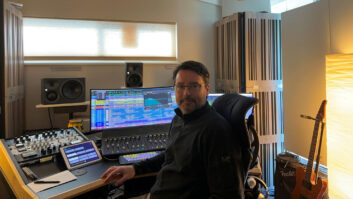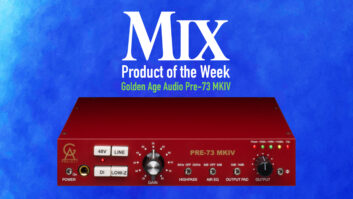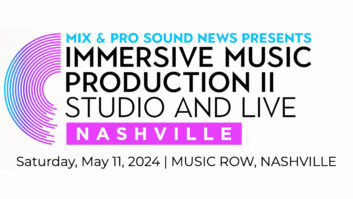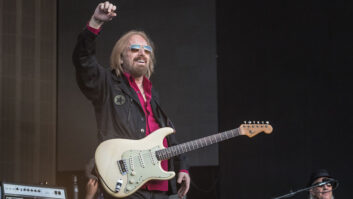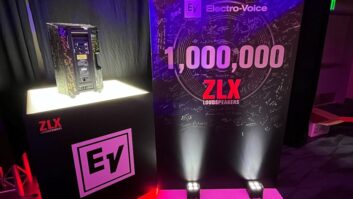Wunderkind is probably the most appropriate label for Kevin “KD” Davis. Still in his early 20s, Davis is a one-man mix factory. He works six to seven days a week at his favorite Los Angeles room, Larrabee North’s Studio One, where he focuses on cranking out pop and R&B chart-toppers for the likes of Coolio, Montell Jordan, Brandy, K-Ci & JoJo, Adina Howard, Somethin’ for the People, Keith Sweat, SWV, Chante Moore, Oleta Adams, New Edition…the list goes on and on.
Maybe Davis relates so well to what kids are buying because he’s not that far away from being one himself. Or maybe music just runs in his genes: Both of his parents are professionals in the music business. Trying to get some hints about the secrets to his success, Mix dropped into Larrabee one afternoon for a visit and found Davis to be low key, friendly and modest to the point of shyness when discussing the subject of his early-in-life achievements.
You were a recording studio rugrat.
Yeah, I was born into the music business. My father, Mark Davis, is a producer who worked with people like Sly Stone and Natalie Cole, and my mother, Ivory Stone, is a songwriter. She also sang backup for Smokey Robinson; she’s been doing that since I was three or four years old. So I was always around studios, playing in the game room or, many nights, sleeping on the couch.
And I always had some kind of musical equipment around the house that I was trying to have fun with-keyboards or drum machines. Being around studios as a little kid I always wanted to touch all the buttons, and get in there and do something. At age 14 or so I went out on tour with my mom as a roadie, learning the live end of the business, setting up the stage, doing bags, whatever. I did that for a few years and then one of the sound guys suggested that I go to recording school, to take what I knew and apply it at a professional level, so in ’91 I went to the L.A. Recording Workshop. I knew before that that I wanted to work in the studio and make records, but I didn’t know how to get there.
What was your first job after recording school?
I started at Cornerstone Studios in Chatsworth as a runner/assistant. That was a good thing, because at the bigger studios you have to start out as a runner and work your way up to get to be an assistant. But at that type of studio, it’s so small you just do everything. I was hired as an assistant, but if somebody needed food I went to get it. I was there about a year, and I got a great deal of knowledge. Then I moved to Soundcastle and was a full-time assistant for about a year-and-a-half, and then I went independent.
That’s pretty quick to go out on your own.
I had a couple of clients I was working with a lot, tracking for, at Soundcastle. A lot of times people would come in, they didn’t have an engineer, and they would need someone to help them track. I built up a good relationship with some of those people who kept coming in, and I just started urging them to give me a shot at doing their mixes. In my early stage it kind of sounded strange…
You mean it sounded strange to ask them?
[Laughs] No, I mean the mixes sounded strange! Because I was just trying to get the gig. But the clients heard that I had something, so they kept going with me, and I still work with a lot of the same people today. Some of my main clients are the same people I started off with. Somethin’ for the People, Laney Stewart, Tricky Stewart-we all got our start together.
So you were developing some clients, doing a few mixes-how did you go from that to being so in demand?
I don’t know, word of mouth? I hope it’s people hearing what I’ve done and liking it. But it’s a blessing, really; it just started snowballing.
You have a lot of loyal clients. Why do you think they stay with you?
A lot of my main clients, we just relate well together, and they know me from when they started, when they weren’t as good as producers, and I wasn’t as good as an engineer. We’ve come up together, so at this point it’s like, they’re a little bit more successful now, I’m a little bit more successful now, why change it? It’s not broken so why try to change it up?
Do you think you’re easy to get along with?
I think so. If a producer comes in here and doesn’t like what I’ve done, I’ll change it. My main thing is I want the song to come off cool. I mix a lot of songs, and not every song is gonna be a hit; it’s not gonna happen-you just can’t make every song be a hit. So, I’ll try to make the producer happy enough so he’ll say, “Kev is cool to work with. I like what he did with the song, and I know he’ll get the job done.”
When I was an assistant, I saw a lot of producers and engineers that were hard to get along with, and I always wondered why. I try to keep everything organized, but still be laid back. Because really, this job is so chill-I don’t have a mean boss, I live right around the corner, I just don’t have that much trouble. You know what I mean? There’s just no reason to stress out too much. I do really try to keep things organized.
There can be stressful moments, though; for example, what do you do when you’re working with a producer and you know that he or she is going down some wrong path that’s going to keep you up all night?
[Laughs] There’s different techniques to head that off. Engineers have their tricks, but we’re not going to give them away here.
Do you work mostly on singles, or on whole albums?
Both, right now. Earlier on, I did mainly singles-one song here or there because my clients were just getting to do one or two songs on an album. But now it seems like five or six songs at least on an album. Lately I’ve built up more of a relationship with labels and the A&R departments. I’ve met a lot of producers through A&R, and it seems like when you get more label connections you’re more likely to get the majority of an album.
What makes an R&B hit? There seems to be such a formula today among songs-what do you think gives a tune that edge that makes people hear “Buy me!”
That’s a good question, because, right now, to me, R&B is in a bit of a lull as far as the creative element goes and having something new that sounds great. It’s like you turn on the radio and hear a sample of something old, over and over again. I think the formula right now for a hit is something that makes the public remember from the old days. That’s why these samples and remakes are selling so much and are on top of the charts. There’s something familiar in every song that brings people back and makes them think of when they first heard the original song. Then, when they have their favorite artist, a rapper like Jay-Z or a singer like Mary J. Blige or Faith Evans on the record, it’s just all that much more-their favorite rapper with the old song that they used to love, together all at once. Right now that’s a hit formula.
Do you think you have a feel for when a song will be a hit? Say when you mixed “Gangsta’s Paradise” for Coolio.
Now that’s a funny one. We were mixing at Encore, and Coolio decided that he didn’t really like the drums on tape, so at about two in the morning he changed all the drum sounds up. We were still mixing at six in the morning, and finally, when we were finished we were so tired that we didn’t even listen to the finished mixes-I just had the assistant print them after we left. The next time I heard it was on the radio, and then it seemed like it was everywhere, and I was like, “That’s the song we did? Sounds pretty good.” So no, I didn’t know it was going to be a hit. But you do get a feel about a track sometimes when you put it up.
Do you have to do a lot of “mixing as arranging”-muting things, compiling vocals, making decisions about what stays and what goes?
It really depends. Sometimes I deal with producers who are organized, and sometimes I deal with producers who are unorganized. I guess it’s about half and half. Sometimes I get a producer who’s got great sounds, everything’s arranged, the backgrounds are comped, everything’s done, and all I’ve got to do is just push up the faders, add a little of my thing to it and get the right balances. But sometimes I have to fly vocals around, change drum sounds and really get into it. Which I don’t mind if it’s a good song; I can get excited about it because I’m adding to what could potentially be a hit. But, when it’s just an “okay” song and it’s really got some work that needs to be done, those are the days I wish I could be at home instead.
My main clients for the most part are pretty well-organized, things are set and done, and we may just add a few things here and there.
When you get tracks, what kind of shape are they in? A lot of engineers these days complain about track sheets, tracks that haven’t been cleaned…
We do get some real crazy stuff, sometimes. But I’ve got a real good assistant here, Steve Macauley, and we just rip up their track sheets and redo and relabel everything.
Do you work mostly from analog or digital masters?
Usually analog 48-track, although lately a lot more has been coming in that was cut on 48-track digital. But I also might transfer tracks to a hard disk, like the Akai DR16. I might transfer the vocals, because it takes SMPTE so quick-it locks up instantly, and when you don’t have to wait for the two machines to lock up it makes the work a whole lot simpler and quicker.
What format do you mix to?
I mix to Quantegy 11/42-inch tape-30 ips at plus nine.
Do you work alone a lot, without the artist or producer being there?
It varies. I like to work alone to a certain point where they can come in and say, “Do this,” or “That’s fine,” and a lot of producers will give me that liberty to do what I do. They come in after 6 or 7 o’clock and make a few changes. With my main clients we tend to have a relationship; I already know how they want it to sound, and they know what I’m going to do, so when they come in there will be just a few things that we have to do.
Do you usually leave your mixes up overnight, spending a day-and-a-half on them?
It depends-with my main clients I usually knock it out in a day if it’s just a straight mix. If we have to change things or put on more vocals I like to get that leisure of taking a day-and-a-half, but sometimes certain clients’ budgets aren’t to that point.
You’re mixing mainly for radio-how do you keep up with the competition?
I listen to a lot of stuff in the car, both CDs and the radio-I don’t listen too much at home because when I go home I’m not really thinking about music. But being in Los Angeles you spend at least an hour a day in the car, so you can be taking care of business when you’re rolling around.
At the studio here they have a Sony digital satellite system that broadcasts a lot of the music channels-R&B, rap, blues, jazz, ’70s, soft and hard rock; I’ll listen to those channels sometimes just to get familiar with what’s playing. I have a MiniDisc player in my car, so to listen to my mixes I record a MiniDisc at the studio.
Why MiniDisc instead of CD?
It’s just easier. Also, the CD thing gets expensive unless you’ve got rewritable. With a MiniDisc, you can record over and over and you don’t scratch them up as easily because they’re in a case. CDs you always scratch up. And you can label the MiniDiscs, so you know which one’s playing. The MiniDisc doesn’t sound as good as a CD, but it sounds a lot better than a cassette does. Like most engineers, I truly hate cassettes.
I’ll burn a MiniDisc through an Apogee filter off of the console stereo bus, and in the car I can get an idea of how it sounds. I know mastering is going to do a little something different to it, but it’s still gonna be in the ballpark.
What do you monitor on in the studio? Do you use the big speakers?
I do a lot of my work on NS-10s-the old style, not the studio version. And I like my little Bose Freestyles that Barney Perkins turned me on to. I think Bose stopped making them for stores, but there’s a private stock if you call the company. I love the way they sound. I often use a mono Auratone for vocal rides, and I do listen some on the big speakers. One of the things I like about this room at Larrabee is that you can throw the mix up on the big speakers and cruise for a while. It doesn’t really hurt your ears.
You don’t do much recording these days-do you miss it?
Not at all. If you’re working with a live band, it’s a whole different story. That’s fun when you’re in there trying to get the right sounds. But if the music is coming out of a keyboard or a drum machine and you’re just getting levels, waiting for it to lock up and then dumping it-no fun.
When you first put up the tape, how do you know what you’re going to feature? Like between the bass and the bass drum on a particular track?
It’s just feel, and it depends on what the bass is doing patternwise and how it sounds, what sound each producer has chosen. The bass and drums have to be hitting to the point where you really feel the track, and you have to understand what the singers are saying. You can’t have the track with just the bass and drums driving where you don’t understand what the vocals are saying. In my early mixes, that was the big problem for me-trying to get a happy medium between the two. Now I always kind of put my vocals on top, and second you’ll hear the kick or bass. Really, the main focal point is just vocals. That’s what sells the song. Because if you’re listening on a bad-sounding radio, what’s important is for somebody to be able to sing the song, rather than to know what the bass drum is doing. It’s work, though, because at the same time you’ve got to have the track hitting.
You always mix on SSL consoles.
I’m hooked on the 9000. It’s hard for me to go back to a G. I like mixing on Neves also, but for me it’s hard to find a Neve room that sounds good. I’ve been at Larrabee for a few years now, and when I go to other rooms it takes me a day-and-a-half to adjust. When I work here, I always know what it’s going to sound like-it’s true-when you play it loud on the big speakers and when you play it in your car.
A lot of tracks you’ve been working on lately have that really low, woofy, rubbery bass sound. What might you do to give it enough definition in the mix to work well with the drums?
I like to use the Distressor on drums, and I’ll also use it on the bass; I’ll just change the attack and release of each. The Distressor is great because you can manipulate it so much. And, on the kick I might use an API 550A EQ-I love the sound of those-and on the bass something like a Pultec.
So a tighter EQ on the kick, and more of a wash on the bass. And you might tie them together using the same type of compressor.
Yes.
When your tape comes in, what’s the first thing you do?
I put it on and throw up the faders to see what’s goin’ on, see what kind of song it is: Is it a good song or not, does the singer sound right? Then I’ll listen to it instrumentally, see what’s not good, so I can take it out or throw it far back in the mix or fix it! I’ll listen for what’s good that I can feature and see what I can do to make it better. Sometimes you can’t really do much. No matter how much fixing you do, it’s just going to be what it is. Then I’ll lay the board out how I want it, see if I have to crosspatch.
Do you listen to rough mixes of the song?
If they have one they like. You can hear the song how it was when they first wrote it. Sometimes it doesn’t sound great, but they like the way it felt.
What’s your favorite gear to use on vocals?
I love the Avalon 2055 on vocals-it’s smooth. I also like to use LA-2As and Summit compressors, and maybe a Focusrite Red 3 compressor/limiter. I like GML or API EQ on the backgrounds.
Do you use much board EQ?
I’ll do lot of taking out of stuff that I don’t like with outboard EQ, then I’ll use the EQ on the board to bring out stuff that I do like. I love being able to use the E selection EQ on the J Series board.
Do you use the SSL stereo compressor?
No, I think it makes things sound a little small. I do use the Focusrite Red 3 across the stereo bus a lot. Focusrite is the smoothest, it seems to warm stuff up a lot. It doesn’t seem to squash things, but overall it makes it sound like a record. I also use an NTI as a stereo EQ.
What gear do you own?
The Akai hard disk recorder, the Bose Freestyles, NTI EQs, and I just ordered the Avalon 2055, and a Focusrite Red 3.
What effects do you like?
I like the Sony D7 as a stereo delay, and of course like everybody else I have to have my PCM-42s. The Sony V-77 is pretty awesome, and I’ve been using an old Mutron a bit on bass tracks lately.
What do you listen to for fun?
I like Faith Evans, some of Eightball, and Jay-Z is one of my favorite artists. I like R. Kelly, DJ Quik, TQ, Outkast, and I love A Tribe Called Quest.
Do you want to produce?
Most definitely. Actually, I’m getting ready to start a project for an artist named Soleil that I’ll be co-producing. That’s got to be the next step. But it’s hard, because I do love what I do. And I love that when the mix is done, I’m done working. I can go home, and I don’t have to think about anything else.
Do you have any engineering heroes?
Well, I have a lot of people whose mixes I like. Tony Maserati and Steve Hodge both do a great job. I love Jon Gass’ work with Babyface. Manny Marroquin, Dexter Simmons…when I was coming up I listened to a lot of Dave Way, Barney Perkins, Jon Gass-they were the guys I wanted to be like. I wanted to be as busy as they were, so I was listening to what they were doing, trying to see what it was about them that made them get the kind of work that they did. I wanted to have my own style, but at the same time I wanted to be commercially acceptable.
What were some of those things that they did?
Some of the effects and tricks that they were using then were really cool. There was a lot of trickery that engineers were doing in the late ’80s and early ’90s with drum sounds, delays, gated reverbs and stuff like that. Music has changed now, and mixing is a much more straight-ahead situation these days. It seems like lately it just has to hit, and it’s got to hit hard.
So what’s a trick you might use?
[Laughs] Sometimes I try not to listen from a mixer’s perspective, but rather to listen to the song from a regular person’s perspective, as if I just like the song. I try to figure out what it is I like about the song, not, “Is the kick hitting at 150 Hz?” I just listen to the song and what it feels like, because the average person wants to know what it feels like, and if they can sing it, and that’s what’s gonna make it come together.
Montell JordanLet’s Ride, “Somethin’ for the Honeys,” “Payback,” forthcoming

